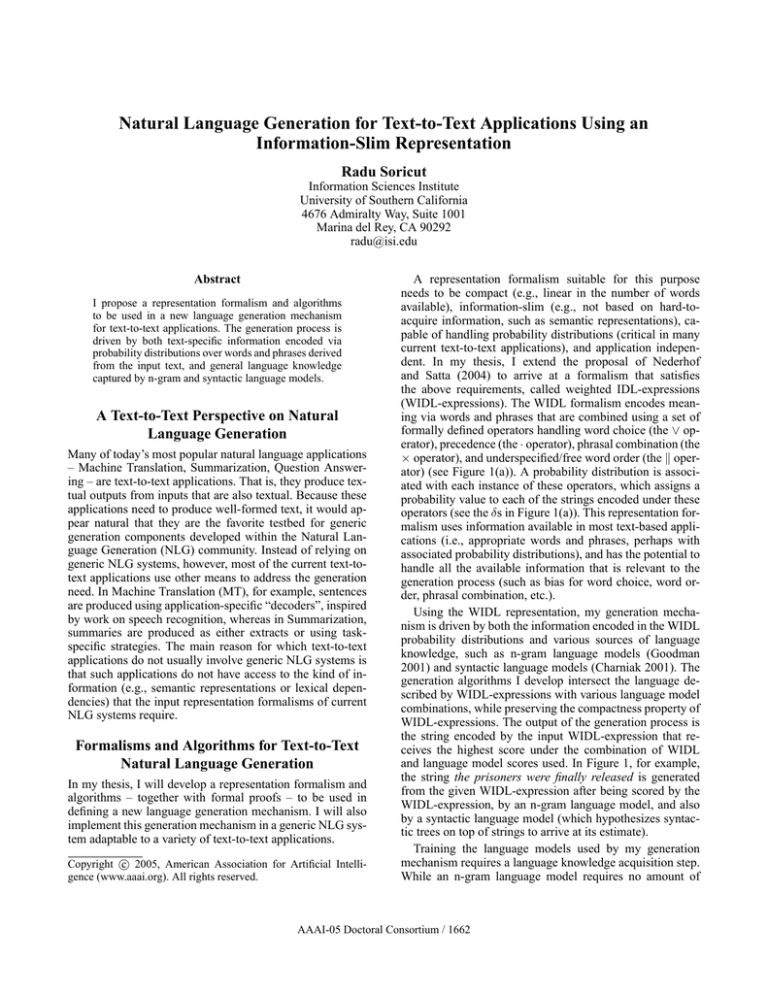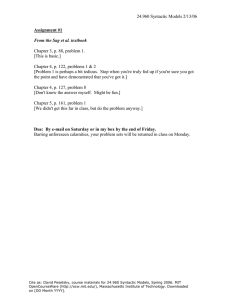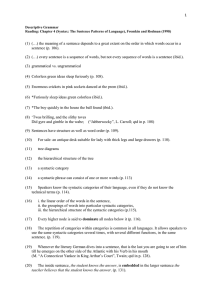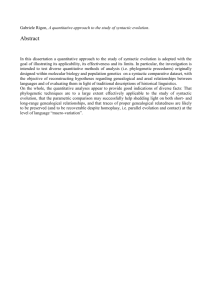
Natural Language Generation for Text-to-Text Applications Using an
Information-Slim Representation
Radu Soricut
Information Sciences Institute
University of Southern California
4676 Admiralty Way, Suite 1001
Marina del Rey, CA 90292
radu@isi.edu
Abstract
I propose a representation formalism and algorithms
to be used in a new language generation mechanism
for text-to-text applications. The generation process is
driven by both text-specific information encoded via
probability distributions over words and phrases derived
from the input text, and general language knowledge
captured by n-gram and syntactic language models.
A Text-to-Text Perspective on Natural
Language Generation
Many of today’s most popular natural language applications
– Machine Translation, Summarization, Question Answering – are text-to-text applications. That is, they produce textual outputs from inputs that are also textual. Because these
applications need to produce well-formed text, it would appear natural that they are the favorite testbed for generic
generation components developed within the Natural Language Generation (NLG) community. Instead of relying on
generic NLG systems, however, most of the current text-totext applications use other means to address the generation
need. In Machine Translation (MT), for example, sentences
are produced using application-specific “decoders”, inspired
by work on speech recognition, whereas in Summarization,
summaries are produced as either extracts or using taskspecific strategies. The main reason for which text-to-text
applications do not usually involve generic NLG systems is
that such applications do not have access to the kind of information (e.g., semantic representations or lexical dependencies) that the input representation formalisms of current
NLG systems require.
Formalisms and Algorithms for Text-to-Text
Natural Language Generation
In my thesis, I will develop a representation formalism and
algorithms – together with formal proofs – to be used in
defining a new language generation mechanism. I will also
implement this generation mechanism in a generic NLG system adaptable to a variety of text-to-text applications.
c 2005, American Association for Artificial IntelliCopyright gence (www.aaai.org). All rights reserved.
A representation formalism suitable for this purpose
needs to be compact (e.g., linear in the number of words
available), information-slim (e.g., not based on hard-toacquire information, such as semantic representations), capable of handling probability distributions (critical in many
current text-to-text applications), and application independent. In my thesis, I extend the proposal of Nederhof
and Satta (2004) to arrive at a formalism that satisfies
the above requirements, called weighted IDL-expressions
(WIDL-expressions). The WIDL formalism encodes meaning via words and phrases that are combined using a set of
formally defined operators handling word choice (the ∨ operator), precedence (the · operator), phrasal combination (the
× operator), and underspecified/free word order (the k operator) (see Figure 1(a)). A probability distribution is associated with each instance of these operators, which assigns a
probability value to each of the strings encoded under these
operators (see the δs in Figure 1(a)). This representation formalism uses information available in most text-based applications (i.e., appropriate words and phrases, perhaps with
associated probability distributions), and has the potential to
handle all the available information that is relevant to the
generation process (such as bias for word choice, word order, phrasal combination, etc.).
Using the WIDL representation, my generation mechanism is driven by both the information encoded in the WIDL
probability distributions and various sources of language
knowledge, such as n-gram language models (Goodman
2001) and syntactic language models (Charniak 2001). The
generation algorithms I develop intersect the language described by WIDL-expressions with various language model
combinations, while preserving the compactness property of
WIDL-expressions. The output of the generation process is
the string encoded by the input WIDL-expression that receives the highest score under the combination of WIDL
and language model scores used. In Figure 1, for example,
the string the prisoners were finally released is generated
from the given WIDL-expression after being scored by the
WIDL-expression, by an n-gram language model, and also
by a syntactic language model (which hypothesizes syntactic trees on top of strings to arrive at its estimate).
Training the language models used by my generation
mechanism requires a language knowledge acquisition step.
While an n-gram language model requires no amount of
AAAI-05 Doctoral Consortium / 1662
SBLM = 7.1*10−12
S
|| (finally, V (X(the . prisoners), X(the . captives)) .
δ2
δ1 .
were . released)
NP−C
δ1 = { the prisoners : 0.7 , the captives : 0.3 }
δ2 = { the prisoners were released finally : 0.05,
the captives were released finally : 0.05,
_all_other_ : 0.02 }
score
VP
NPB
DT
NNS
VBD
ADVP
VP−C
RB
VBN
{(the prisoners) were (finally) released}
0.7
WIDL =0.014
score
(a)
0.02
NGLM = 2.3*10−7
score
(b)
Figure 1: Mapping WIDL-expressions into syntactic parse trees. The WIDLscore results from the probability distributions δ1
and δ2 ; the NGLMscore results from evaluating the realized string the prisoners were finally released under the n-gram language
model, and the SBLMscore results from evaluating the hypothesized syntactic tree under the syntactic language model.
annotation/supervision to train, a syntactic language model
requires unobserved variables (the syntactic trees) to train
its parameters. The amount of annotated data available for
this purpose (1 million words of English from the Wall
Street Journal, known as the PennTree Bank) is insufficient
to provide high coverage for learning lexical dependencies,
which are critical for a high-performance syntactic language
model. Bootstrapping techniques, such as self-training and
co-training (Bloom & Mitchell 1998), have been shown to
be ineffective for learning lexical dependencies for improving state-of-the-art parsing accuracy (Steedman et al. 2003).
In the context of learning lexical dependencies for syntactic
language modeling, however, the accuracy of a syntactic language model increases if self-training is used. Using a lexicalized statistical syntactic parser, I automatically acquire
large amounts of language knowledge in the form of lexical and syntactic dependencies from unannotated text. These
dependencies, albeit noisy, help increasing the ability of the
syntactic language model to distinguish bad sentence realizations from good ones. This is considerably less expensive
than relying on human expertise to create such knowledge,
either by hand or through a corpus annotation process. It
also has the advantage that new language knowledge events
can easily be learned for different genres, domains, and even
languages.
Current Status of Formalism and Algorithm
Development
I have already defined the formalism of WIDL-expressions,
and devised algorithms for intersecting WIDL-expressions
with n-gram language models. I have proved the correctness
of these algorithms, and showed that their complexity is linear in the complexity of the input WIDL expression. I have
also implemented a syntactic language model starting from
a lexicalized parsing model proposed by Collins (2003), and
bootstrapped the model using large amounts of unannotated
text. I performed preliminary experiments that show that the
self-training procedure helps the syntactic language model
perform significantly better on a word-ordering task. I also
have empirical results that show that a log-linear combination between an n-gram language model and a bootstrapped
syntactic language model outperforms any of these models
taken separately on a word-ordering task.
Future Work on Text-to-Text Natural
Language Generation
I still need to develop and implement algorithms for intersecting WIDL-expressions with a combination between an
n-gram language model and a syntactic language model, and
to prove the formal properties of these algorithms. I also plan
to show the effectiveness of this generic, WIDL-based NLG
system by implementing two end-to-end text-based applications. The first application is a machine translation system. I plan to capture translation model information using
the probabilistic framework of WIDL-expressions, and target language model information using an n-gram and syntactic language model combination. The second application
is a headline generation system. For such a summarization
task, I plan to use information extraction techniques to associate scores with key words/phrases in the document(s) to
be summarized, and map them into WIDL-expressions. An
n-gram and syntactic language model combination will be
in charge with realizing the most probable headline from a
given WIDL-expression.
References
Bloom, A., and Mitchell, T. 1998. Combining labeled
and unlabeled data with co-training. In Proceedings of the
11th Annual Conference on Computational Learning Theory, 92–100.
Charniak, E. 2001. Immediate-head parsing for language
models. In Proceedings of the 39th Annual Meeting of the
Association for Computational Linguistics.
Collins, M. 2003. Head-driven statistical models for natural language parsing. Computational Linguistics.
Goodman, J. 2001. A bit of progress in language modeling.
Technical Report MSR-TR-2001-72, Microsoft Research.
Nederhof, M.-J., and Satta, G. 2004. IDL-expressions: a
formalism for representing and parsing finite languages in
natural language processing. Journal of Artificial Intelligence Research 287–317.
Steedman, M.; Osborne, M.; Sarkar, A.; Clark, S.; Hwa, R.;
Hockenmaier, J.; Ruhlen, P.; Baker, S.; and Crim, J. 2003.
Bootstrapping statistical parsers from small datasets. In
Proceedings of the 11th Conference of the European Association for Computational Linguistics.
AAAI-05 Doctoral Consortium / 1663









